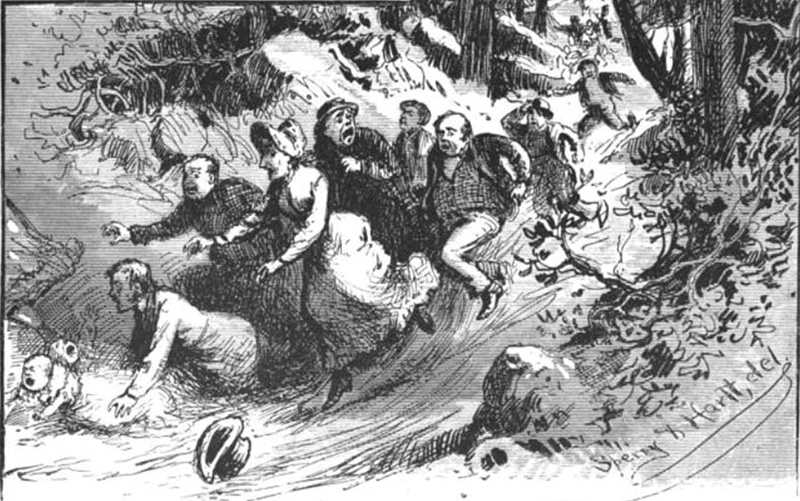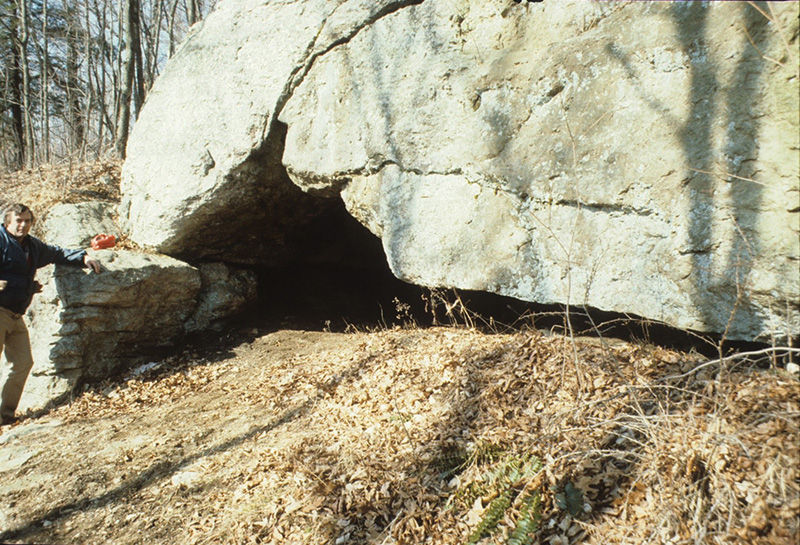 This article appears in the Summer 2024 issue
This article appears in the Summer 2024 issue

It isn’t a groan, nor a crash, nor a roar,
But is quite as bloodcurdling to hear,
And has stirred up more theories crammed with learned lore
Than you’d care to wade through in a year.
These few lines from a poem written in 1884 by Reginald T. Sperry sum up the history of the Moodus Noises. Since the earliest days of English settlement in the 1600s, folks correctly identified the strange rumblings in the Moodus section of East Haddam, Connecticut, as earthquakes that are heard more than felt, but it was centuries before science explained the cause and mechanism for their creation.
The Wangunk, having occupied the area for hundreds of years before the English arrived, had become familiar with the noises, and discovered a cave that became a sacred landscape in Native culture. Their name for the area meant “place of noises.” The state settled on “Machimoodus” for the park on the Salmon River.

Illustration from Moodus Noises: A Rhyme for the Fourth of July by Reginald T. Sperry, 1884.
The colonists did not appreciate the Native activities that took place in and around the cave, calling the rituals “a prodigious trade of worshipping the devil.” Nor did they appreciate their own minister’s. Some of the Haddam settlers had crossed the river from the west side of the settlement by 1685, perhaps to get away from the Rev. Jeremiah Hobart, with whom they did not get along. Puritan ministers routinely used natural phenomena to keep their congregations in line. Hobart was no different, saying he hoped the “strange bellowing noises and earthquakes lately heard may awaken them to righteousness.” This is the first written account of the noises, preserved in an address to the General Assembly in 1702, but Hobart’s diatribe was apparently unsuccessful as the folks on the east side of the river became a separate town in 1734 with a minister of their own choosing.
The myths and legends that developed during this period reflect the relationship and tension between the Native people and the colonists, as well as among the colonists themselves. One of the colonists’ stories explains the noises as the result of the association of the Native god Hobomocko who lived in the cave with the magical white witches from East Haddam and the evil black witches of Haddam who fought all the time. When Hobomocko, who lit the cave with a wand tipped with a glowing pearl, got tired of them, he waved the wand and blew the witches out of the cave, creating the noise. This illustrates more about how the Puritans got along with each other rather than Native beliefs.
By 1790 the explanations for the noises began to take on a scientific explanation, beginning with the tale of a Dr. Steele, who supposedly came from Great Britain to study the sounds and ascertain their cause. He was secretive with his research, occupying a building in the woods where he covered the windows and filled the cracks so that no one could see what he was doing. Eventually, he proclaimed that he had found the cause. He had “dug up two pearls of great value,” which he called carbuncles, near the Salmon River. By removing them, the noises would stop, but there were smaller ones still growing, and the noises “would be again heard, in the process of time,” describing the periods of quiescence experienced through the centuries.
During the 19th century, the science of geology evolved as did the theories for the Moodus Noises. In 1836 historian John Warner Barber explained that “mineral or chemical combinations, exploding at depth of many thousands of feet” created the sounds. By 1840, the famous Yale professor Benjamin Silliman rejected that idea as “inadequate to account for the movements extending at intervals through centuries.” Just a year later, Wesleyan professors weighed in on the subject, agreeing with Silliman saying that the “decomposition or combustion of some mineral substances always manifest themselves so differently from any circumstances connected with the Moodus noises.” They also discussed various other theories at the time called Galvanism and Magnetism but finally settled on the earthquakes being “nothing more than the electricity called into activity by mechanical power, by chemical action, and by heat.”
By the end of the century, resident Hosford B. Niles put forth the theory “that there is a subterranean passage leading from a large cave near Mt. Tom to the sea, and that the noises are produced by certain delicate combinations of wind and tide.” In the 1960s, this enticed another resident, teacher Jim Meyer, to test this proposal for his Master’s thesis. After tramping the countryside and studying tidal and meteorological conditions, he concluded that there was no correlation.
It wasn’t until the 20th century that geologists conducted surveys and identified cracks in the Earth’s crust called faults as the cause of earthquakes. The explanation for the mechanism for creating the noise came later, in the 1980s. Geologic mapping revealed faults across the landscape. But which faults were active and causing the earthquakes in Moodus?

Cave sacred to the Wangunk (on private property), East Haddam, CT. Image Credit: Alison Guinness.
Connecticut seismicity isn’t like California where you can drive out to the San Andreas Fault, set up equipment, and document seismic activity. Here, the rocks are older and more broken up. And we are in the middle of a tectonic plate not on a fault line like the San Andreas. Because of this, the energy created by an earthquake travels much farther on the east coast and can be felt long distances from the origin and many faults here do not have surface expression, which complicates the study of earthquakes like the Moodus Noises.
When the Connecticut Yankee Atomic Power Plant (CY) was proposed for Haddam Neck in the 1960s, a long period of research began. Because of the known seismicity, CY was required to ascertain the strongest earthquake on record and construct a facility that would withstand at least that powerful of an earthquake.
In the 1980s, geologists experimented with hydrofracking in Moodus and near Gillette Castle by drilling some of the deepest holes at that time and photographing the boreholes to determine if any faults actually existed. Serendipitously, a swarm of hundreds of earthquakes occurred, some so small that they were not measurable on the Richter scale. An array of seismometers was installed, including one in the basement of resident Kathy Wilson who lived near the Moodus borehole.
This research verified that faults existed in the area and that they could be active in the creation of the seismicity responsible for the Moodus Noises. There was still the question of why there was more noise than shaking associated with these earthquakes. John Ebel from the Weston Observatory in Boston determined that the earthquakes were shallow, within a few kilometers of the Earth’s surface, and that the high frequency vibrations coupled with the atmosphere to create sound rather than shaking, although mild shaking is sometimes felt.
It was all quite exciting and interesting until the October 1989 Loma Prieta earthquake in California. After that, President George H. W. Bush ordered a re-evaluation of the earthquake hazard across the country and the Moodus seismic area was downgraded. Funding disappeared, the seismic array was discontinued, and interest waned. When CY was closed, decommissioned, and removed, most of the research ended.
Recent work by Robert Altamura and others, however, has shined a new light on Moodus seismicity. New technology, such as remote sensing, including LiDAR (Light Detection and Ranging), allows scientists to examine natural environments with more accuracy and precision. Following the mapped Eastford Fault and using LiDAR lineaments, Altamura and his team propose that this fault extends south through Moodus, with evidence from the faulting seen in the boreholes to determine that this is the location of the fault causing the Moodus Noises.
While this theory removes the mystery, the Moodus Noises are no less intimidating than they were when the Wangunk first noticed them. Most folks are just as happy that they’ve been quiet for a while, but perhaps that’s only because the carbuncles are still growing.
Alison C. Guinness is a resident of East Haddam where she researches the local earthquake phenomenon called the Moodus Noises. She also studies Portland brownstone and other quarrying in the Connecticut River valley. She curated an exhibit at the Connecticut River Museum on brownstone and searches for important uses of sandstone around the world.
